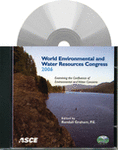Estimating Riparian ET through Remote Sensing in the Middle Rio Grande
Publication: World Environmental and Water Resource Congress 2006: Examining the Confluence of Environmental and Water Concerns
Abstract
Riparian evapotranspiration (ET) along the Rio Grande River has become a major hydrological as well as political issue in New Mexico. The State of New Mexico has spent millions of dollars in recent years to eradicate riparian vegetation without being able to quantify the change in regional ET. Many studies have focused on measuring ET of individual riparian vegetation types, mainly saltcedar and native cottonwood. However, the riparian vegetation in the Middle Rio Grande varies in density and species. Spatial variations in climate, soil type and depth to groundwater causes variations in ET, as well. It is obvious that in order to obtain more accurate measurements, multiple sampling points are needed; thus, making the process costly and impractical. An alternative solution, which is also cost-effective, is to use remotely sensed data to estimate ET over large areas. This remote sensing approach combines regional satellite data with localized ET measurement to calculate regional ET. REEM (Regional ET Estimation Model) is a process that uses the energy balance at the top of the canopy to estimate ET. REEM uses data from the Advanced. Spaceborne Thermal Emission and Reflection radiometer (ASTER) on board NASA's Terra satellite. These data are: surface temperature, albedo and NDVI to calculate net radiation (Rn), ground heat flux (G) and sensible heat flux (H). The ET is then calculated as the residual of the energy components. The REEM model was used to calculate regional ET values for the Riparian vegetation of the Middle Rio Grande. This paper compares the ET values for various vegetation types (saltcedar and cottonwood) using remote sensing and ET derived from Eddy Covariance Flux Towers.
Get full access to this chapter
View all available purchase options and get full access to this chapter.
Information & Authors
Information
Published In
Copyright
© 2006 American Society of Civil Engineers.
History
Published online: Apr 26, 2012
ASCE Technical Topics:
- Aerospace engineering
- Business management
- Climate change
- Climates
- Ecosystems
- Engineering fundamentals
- Environmental engineering
- Evaporation
- Evapotranspiration
- Hydrologic engineering
- Hydrology
- Measurement (by type)
- Political factors
- Practice and Profession
- Public administration
- River engineering
- Rivers and streams
- Satellites
- Sensors and sensing
- Space exploration
- Vegetation
- Water and water resources
Authors
Metrics & Citations
Metrics
Citations
Download citation
If you have the appropriate software installed, you can download article citation data to the citation manager of your choice. Simply select your manager software from the list below and click Download.
